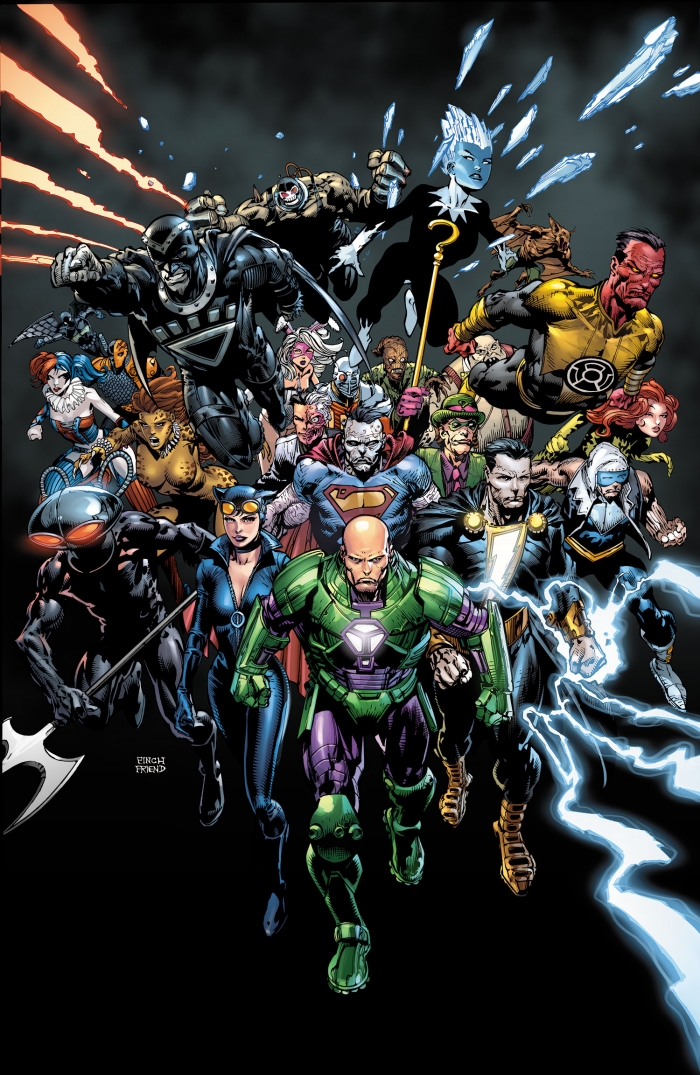Forever Evil (hardcover)
FTC Statement: Reviewers are frequently provided by the publisher/production company with a copy of the material being reviewed.The opinions published are solely those of the respective reviewers and may not reflect the opinions of CriticalBlast.com or its management.
As an Amazon Associate, we earn from qualifying purchases. (This is a legal requirement, as apparently some sites advertise for Amazon for free. Yes, that's sarcasm.)

Geoff Johns proves time and again that he not only knows how to play with all the toys in the DC sandbox, but that he can do it better and use them in ways previously untried.
I've always enjoyed DC's decades-long riff on the Many Worlds theory. So much so that I have my Green Lantern #40, with Hal Jordan and Alan Scott learning about Krona and his multiverse-creating experiment, framed on my office wall, next to my two-part Justice League of America: "Crisis on Earth-3" issues. Those issues, introducing the evil mirror-image Justice League members known as the Crime Syndicate, form the keystone to this epic tale where the bad guys have been playing the long game -- and finally win (at least for a little while). The Crime Syndicate was quickly followed by the Lawless League of Earth-A, but that team didn't have nearly the resonance of the Crime Syndicate.
The Crime Syndicate got lost after the Crisis on Infinite Earths, and saw a reboot in the Grant Morrison tale, Earth Two. But now, with the return of Earth 2 being a home of heroes, the CSA has been shunted once again to Earth-3 -- and it's a world that has been destroyed, forcing them to find a new home, one that they can take over and bend to their will.
This version of the CSA is very much like the one we saw in Morrison's tale, although we get to know them in greater detail, fleshing them out more than we've ever known them before. Clark Kent is Ultraman, an Earth astronaut who gets powers from ingesting kryptonite and whose weakness is yellow sunlight. Lois Lane is Superwoman, an super-strong Amazon with a barbed lasso of submission. Thomas Wayne Jr is Owlman, who killed his own parents in order to stop them from squandering the family fortune. Power Ring is Hal Jordan, who knows nothing but fear as he wields the green mystic energy of the ring that controls him. Johnny Quick is a speedster like the Flash, and his main squeeze is Atomica -- whom we all saw prior to this as the new Atom in Justice League of America, unaware that she was a forerunner to the events that would bring the CSA across the dimensional barrier.
With their arrival, there is also a loss -- the loss of the Justice League, the Justice League of America, and the Justice League Dark. Batman and Catwoman have survived from their respective teams, as has Cyborg and John Constantine (whom you won't find in this book -- check out Justice League Dark: Rebirth of Evil to find out what he did during the crisis). Batman is determined to find a way to defeat the Crime Syndicate, but that, interestingly enough, is not what this story is about.
No, for all it's darkness, all it's evil-run-amok, all it's wall-to-wall action and widescreen cinema feel, this story is about the redemption of possibly the most evil villain of the entire DC Universe: Lex Luthor.
Lex is busy being Lex at the onset of Forever Evil, trying to strong-arm and blackmail Thomas Kord to sell his business, running through a litany of all the unhappiness that will plague his family should he not accede. When Lex lets Thomas die when the Crime Syndicate cuts all the world's power, we're not really all that surprised. Nor are we surprised when Lex tests his five-year-premature clone of Superman, Subject B-Zero, by having him follow the command to murder Lex's security guard, Otis.
But over the next handful of days that bring Lex from this point to rallying former villains like Black Manta and Captain Cold to bring about the defeat of the Crime Syndicate -- not to mention his saving Superman's life -- we start to see a new side of Lex, a side that Lex himself probably could not formerly admit existed.
He's learned loss. And he's learned compassion. And that, above all else, is what makes Forever Evil a worthwhile journey. Yes, the David Finch artwork makes it beautiful to read, and the Ethan Van Sciver covers (including all the alternates) are to be pored over slowly. But it's this Campbellian quest, this hero's journey undertaking by Lex Luthor, which forces the reader to ask if anyone has to be forever evil.
I still have some questions left unanswered in this book (far fewer than I have in the outside titles that weave in and around the central arc), and some of them are destined to propel future storylines.
- Who sealed the dimensional rift? Deathstorm, when we weren't looking?
- If Subject B-Zero is a clone of Superman, why are his powers opposite in regards to freeze-vision and flame-breath?
- Who is out of frame, talking to the Anti-Monitor?
- How did Lex Luthor get out of the orange prison jumpsuit he wore in Trinity War and return to being a captain of industry at the beginning of Forever Evil, since one storyline abuts the other?
If someohow you managed to avoid all the Forever Evil issues and tie-ins, then this is the book you need to pick up. It changes the face of the New 52.


